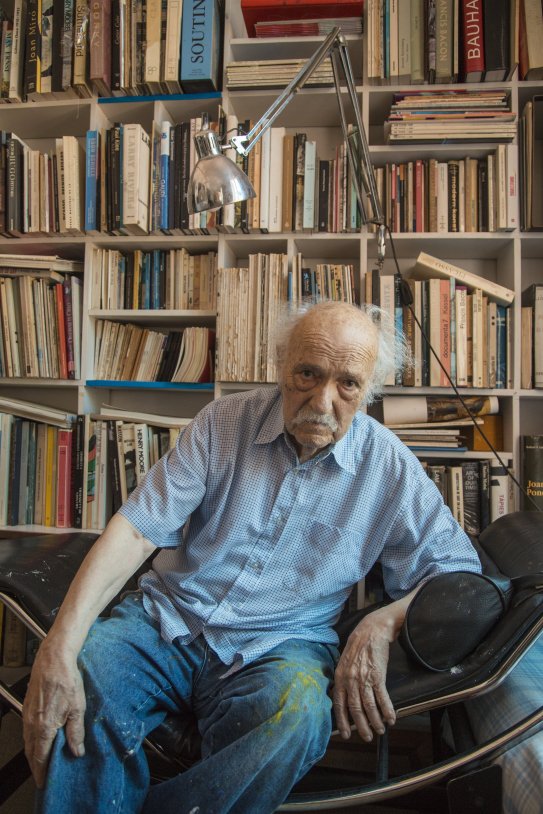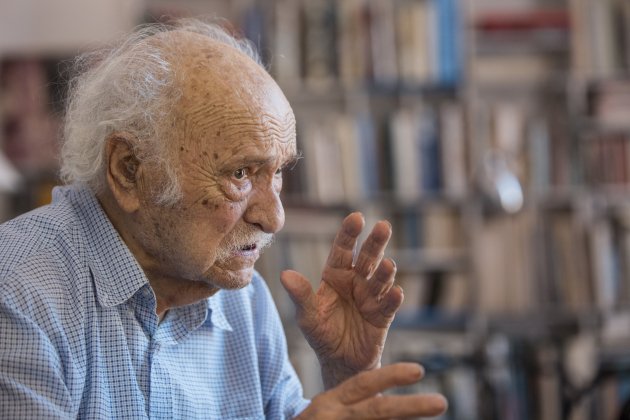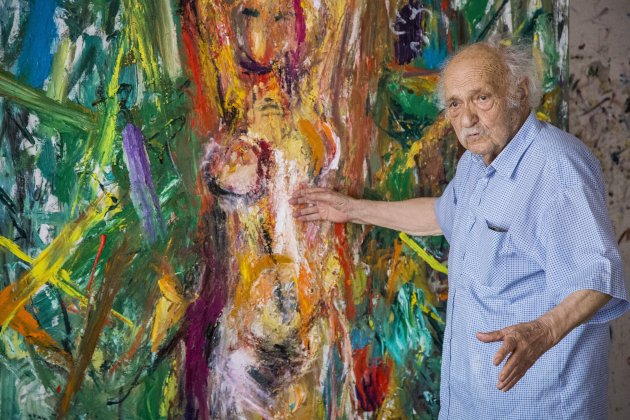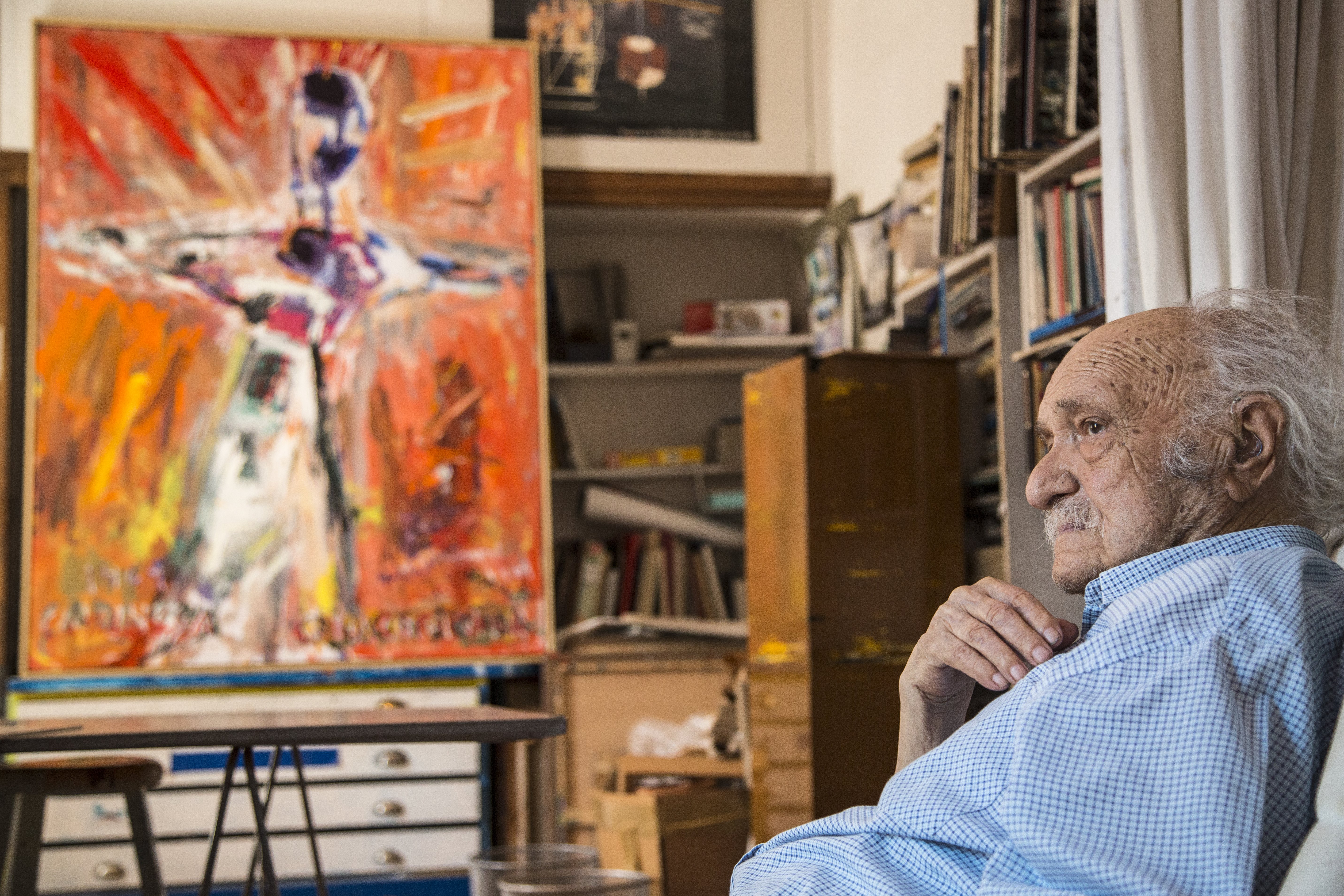The painter from the Martorell area of Catalonia, Jaume Muxart, has painted the figure of a man without skin in honour of the president of the Catalan government, Carles Puigdemont. Muxart met him on 22nd April at the commemorative ceremony to celebrate the 850th year of the Hospital of Sant Joan de Déu of Martorell. When he remembered Puigdemont's promise, just after being appointed, that he would "give up his skin" for Catalonia, Muxart decided to paint his first political picture: Catalonia crucified.

Jaume Muxart was born in Martorell in July 1922 and began to paint in the 1940s. In the 1950s, he became one of the creators of the Taüll group, an artistic and avant-garde trend that also included the likes of Antoni Tàpies, Marc Aleu and Josep Guinovart. At a time when the conventional definitions of art and artist had been blurred by the conceptual and formal shaking up by the avant-gardes, Muxart crossed the border. Thanks to a scholarship, he lived for two years in Paris, and it was not a trivial episode in his life because it allowed him to know the works of Van Gogh, Leonardo and Cézanne, among others; without forgetting his Spanish references, Velázquez and Goya. In addition, his meeting with Picasso allowed him to discover a fascination for cubism. Subsequently, in 1979 he was appointed professor at the Faculty of Fine Arts at the University of Barcelona. Currently and since 2010, the Muxart space of Art and Contemporary Creation displays a good part of the artist's work.
“If I was not a painter, I would already be dead,” muses the 95 year old Jaume Muxart. The problems of vision, increasingly pronounced, have not stopped his constant yet changing creativity. Now, Muxart has decided to paint his first political picture with the title, Catalonia crucified. “It is a figure that I have been drawing for a long time, but I threw it to the ground because I didn't like it enough,” he explains, without hesitation, emphasising the making and unravelling of an artist's work, and affirming that behind every picture are dozens of shaped ideas that will never come to light, and they remain hidden there, under layers of painting.

Jaume Muxart in the studio located on the terrace of his home in Barcelona / Photo: Sergi Alcàzar
Muxart shuffles between the piles of books, catalogues, sketches and pictures - some painted by him and others by his wife, Roser Agell - and finally finds what he's looking for: the book that includes the drawings of the collection, Figures of the light. One of the pages has been pulled out in one of his attacks of inspiration: the figure that will later become the one of a man who suffers and, through suffering so much, no longer has skin. The painting, which was initially included in the aforementioned collection and had “a small role”, was transformed to Catalonia crucified after the painter's meeting with Puigdemont.
“At the last moment I made it myself.” Muxart looks at the picture, which still rests between the walls of his studio, situated in the centre of Barcelona. “This figure seems to give up its skin, like Puigdemont.” As mentioned, Muxart met Puigdemont three months ago in the event marking the 850th year celebrations of Martorell's Hospital of Sant Joan de Déu, when the painter gifted a commemorative work to the hospital. “When I met Puigdemont, I saw it clearly and I told him that he had kept his word, that he was giving up his skin."
But the symbolism of the painting does not end there. In the bottom there is a date: 1469, the year in which the Catholic Monarchs were married. “This is the date that changed everything. From that moment, Catalonia lost its freedom,” says Muxart in a melancholic tone. “With the wedding of the Catholic Monarchs, we have never had a capital of Catalonia again, nor a capital of Spain in Catalonia. They married, but we have never been able to divorce. Now it could happen, but I do not think that we'll achieve it; we do not have enough strength,” he says, resigned. However, he adds immediately, with an outburst of hope: “Hopefully I'm wrong and we can be free once and for all!”

Muxart says that he has always felt a separatist, and he comes from a family with deep Catalan roots. In addition, the painter explains that the two years he lived in Paris also made a mark on him in this issue and on many others. “In Paris I had many pro-independence friends,” he recalls, with a half smile. Muxart's first friend in the French capital was the multidisciplinary artist, Antoni Clavé, who was very Catalan, as well as the poet and writer Josep Palau i Fabre, a very close friend of Clavé. “In 1948, Palau nailed a Catalan flag on top of the Sagrada Familia,” recalls Muxart.
The painter confesses that the initial intention was to give the painting to the Town Council of Martorell, but that he will finally give it to the Catalan government, most likely during September. Now, however, after Catalonia crucified, he has been encouraged to do a second painting. “I am working on a painting about the battle of Ebro, but with this I did not have the concept as clear as I had with the first one. I wanted to paint the Ebro river in the centre in a wavy shape and then do everything from rifles and guns on either side afterwards. Also a bottle for the Quinta del Biberón (the 'baby's bottle draft' during the Civil War) and of other symbols," explains Muxart, regarding the unfinished picture. Now, however, the initial intentions remain deformed in the figure of a female nude. “I had a revelation and I saw that the river had the form of a naked woman.” Thus, the painting has been divided by the nude female-river, which separates two opposite sides: the Republicans (with violet tones) and the supporters of Franco.

Jaume Muxart in front of the painting inspired by the battle of Ebro in his studio in Barcelona / Photo: Sergi Alcàzar
“I have always put my heart in front of my head, I am a painter; I paint better when I do not think, when I let myself be guided by instinct,” he repeats, constantly. And when Muxart talks about painting, ideas flow and he does not hesitate for even a moment. “Instinct passes through my mind and my mind regains intuition.” It is precisely for this reason, by the desire to express instinct, that Muxart is defined as an expressionist painter. “In the abstract it is the head that orders, but the expressionism comes from inside. I express through the expressionism."
Muxart, however, emphasises that his art is not always figurative and that what matters is the balance. “One of the best abstract Spanish painters told me: the more real an abstract painting, the better. What gives it reality is your reality." Likewise, the painter emphasises the importance of colour, and relates an anecdote that includes his friend and colleague, Eduardo Chillida. With his eyes closed, Muxart recites the poem that the Basque sculptor dedicated to him: “Muxart, painter friend, good painter, innocent, hands in colour and the heart in the head.”

When the elderely Muxart is asked about future projects, he responds with a quick and determined stroke, almost with impulse: “The ideas I wanted to do, I've already done. If I want to do anything, I do it." It is this energy that characterizes him so much, and he ends with a masterful phrase: “I prefer five minutes of instinct than one hour thinking.”

